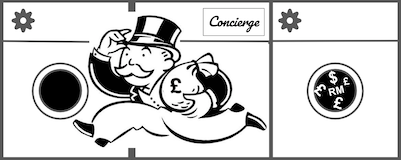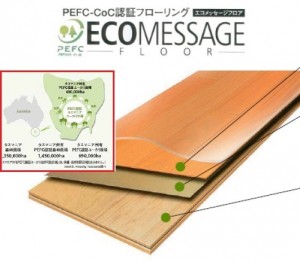 “Eco-friendly and sustainable” – Japanese retailers advertising Ta Ann wood products highlight it Tasmanian origin
“Eco-friendly and sustainable” – Japanese retailers advertising Ta Ann wood products highlight it Tasmanian origin
Last week Ta Ann accused The Green Party in Tasmania of false advertising over logging in Sarawak.
But now advertisements promoting Ta Ann’s products as ‘Eco-wood’ have been challenged by a devastating expose of the company’s own role in Tasmania!
The report, published today by the Huon Valley Environment Centre of Tasmania, spells out Ta Ann’s hypocrisy and it is uncompromisingly titled “Behind the Veneer: Forest destruction and Ta Ann Tasmania’s lies”. [click for report]
Over 50 pages, the troubling expose details how the Sarawak timber giant’s decision to invest in Tasmania was specifically aimed at targeting the growing market for environmentally friendly, sustainable wood products, but has ended up deceiving consumers.
Why Tasmania?
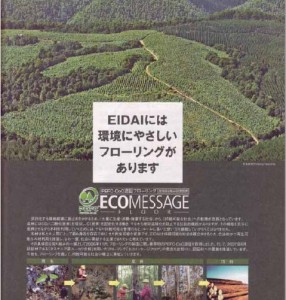 “EIDAI is proud of our ECO-friendly flooring product” – Japanese advertisement for Ta Ann veneer panels sourced in Tasmania
“EIDAI is proud of our ECO-friendly flooring product” – Japanese advertisement for Ta Ann veneer panels sourced in Tasmania
As Ta Ann boss, Hamed Sepawi, himself confessed in 2006, Sarawak has almost completely run out of accessible timber, after 30 years of unrestrained logging by his own cousin and benefactor the Chief Minister.
Tasmania still has extensive hardwood jungles however, and remains one of the most important areas of natural wildlife world wide.
Even more crucially, Australia has received limited accreditation for sustainable timber, compared to Sarawak which is notorious for its destruction of the Borneo jungle.
Hence the constant highlighting of Tasmania as the source of Ta Ann’s new ‘environmentally conscious’ operations.
However, as the investigation makes clear, NONE of the wood that Ta Ann has so far used from Tasmania qualifies as sustainable.
In fact, ALL of the logs so far taken by the company have come from old growth forests, many in high conservation value areas that form crucial habitats for some of the world’s most endangered species. These include Tasmania’s Wedge Tailed Eagle, the Quoll and the Tasmanian Devil.
And NO plantation wood is being used by Ta Ann in its veneer processing mills in Tasmania.
Jenny Webber from the Huon Valley Environment Centre (HVEC) said in a press release today:
“This report reveals, through Right to Information (RTI) documents, that Ta Ann Tasmania received wood from logging areas containing old growth forest, as defined by the Tasmanian Regional Forest Agreement (RFA), on at least 35 occasions throughout the 2009-2011 period. Ta Ann Tasmania is processing wood acquired from the logging of old growth forests, high conservation value forests and forests with recognised world heritage values in Tasmania,”
“Ta Ann’s demand for native forest wood and its large wood supply contract is driving logging in some of Tasmania’s most important and contentious forest areas…. Ta Ann’s operations here in Tasmania are far from eco-friendly and must rank amongst the worst logging practices globally”
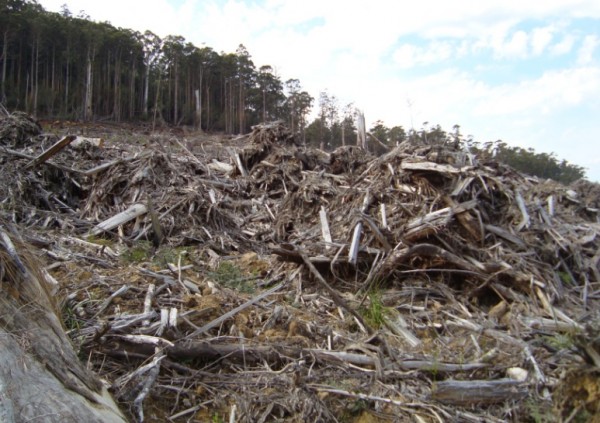 Eco – Destruction – one of many Ta Ann logging coups across old growth forest in Tasmania. Only 10% of the wood felled is used in the saw mill. Some is chipped, but up to 70% of it is just piled up and burnt – destroying a whole area of habitat and rare plant life. So far neither Forestry Tasmania nor Ta Ann have reported a profit from this wanton wreakage
Eco – Destruction – one of many Ta Ann logging coups across old growth forest in Tasmania. Only 10% of the wood felled is used in the saw mill. Some is chipped, but up to 70% of it is just piled up and burnt – destroying a whole area of habitat and rare plant life. So far neither Forestry Tasmania nor Ta Ann have reported a profit from this wanton wreakage
The report points out that Ta Ann Tasmania has in addition received timber for at least 88 logging operations in native forests since 2008, which are defined as having ‘high conservation value’ by ENGOs:
“Ta Ann’s record of environmental destruction in Sarawak continues in Tasmania, with its disregard for this islands old growth forests and wildlife. Ta Ann has tried to portray itself as producing ‘eco-products’ in an attempt to mislead customers as to the origin of their wood and to cover up its disgraceful role in the logging of Tasmania’s ancient forests” [Jenny Weber, HVEC]
Lies!
Despite the evidence, the new report documents how time and again Ta Ann has sought to give the impression that the wood it is using in Tasmania is from plantations and re-growth forests.
Sepawi was quoted in the local Tasmanian paper, The Examiner, as describing their operations as “an innovative rotary peeling process using plantation and regrowth logs”. It is a claim that continues to be made in Ta Ann’s company website, describing its ‘Environmental Management’ and ‘Eco-Wood’.
 Boasts that bear no relation to reality!
Boasts that bear no relation to reality!
Environmentalist critics say that none of these claims are true and that certain politicians and forestry supporters have been so keen to get Ta Ann into the State that they have been giving away valuable timber for a loss. Green MP Paul O’Halloran explained to Sarawak Report that currently plantation wood is about twice as expensive as the ancient forest wood, because it has to be farmed as a business, whereas natural wood comes ‘free’.
He believes this is the reason why Ta Ann has been demanding wood from old growth forests rather than the plantation forests it pledged to use when it entered Tasmania in 2006:
Too big for the peeler – this ancient eucalyptus tree is ear-marked for clear felling by Ta Ann. But it will end up as wood chip!
“They are getting the old growth forest for less than give away prices. We are giving it away and getting a loss, so of course it is cheaper than plantation wood”.
“Plantation wood has a higher value because it is a more consistent product and is easier to process. This means there is more demand for it and so it is more expensive. Also, consumers prefer it as more environmentally friendly and are insisting on it”
“It is purely a question of economics. the old-growth forest is 50% cheaper – that is why they [Ta Ann] prefer it”.
In response the Director of Ta Ann Tasmania, David Ridley, contacted Sarawak Report to deny the company uses old growth wood, because the giant ancient trees are too large for their machines:
“Briefly – we can’t use old growth billets due to the size and quality. We can and do use pruned plantation billets of suitable quality and have trialled unpruned but it is not suitable. You will have seen yesterday that the billets are young growth”
Mr Ridley offered to come back with more details, but so far has not. Investigation by Sarawak Report of the areas that Ta Ann are logging shows that they are clear felling old forests and destroying ancient trees in order to get to the smaller ‘young growth’ trees amongst them. Ta Anns ‘young growth billets’ are trees that are up to a hundred years old and which have been taken by destroying old growth forests.
Taib family business that is acting true to form
The information revealed by the report shows that Ta Ann’s solution has been to say one thing, but do another thing in order to exploit the lucrative Japanese market for ‘eco-wood’. 90% of Ta Ann’s exports from Tasmania end up in Japan, where they are being marketed as certified ‘environmentally friendly’ products, especially flooring.

- Plain incentive – Ta Ann’s 2010 Annual Report shows a keen awareness that the Japanese market is all about ‘eco-friendly’ materials
Ta Ann are publicly implying that their wood is eco-friendly, while raping the forests because it is cheaper to do so! Indeed, no one has ever accused a Taib family company of putting the environment or honesty before profit in Malaysia, so why expect them to act differently in Australia?
 Ta Ann Sdn Bhd – Annual Report 2009 claims the company uses “planted eucalypt”. In fact the report shows that Ta Ann has complained to Forestry Tasmania that its mills are not yet ready to handle planted wood and they can only use trees from old growth forests
Ta Ann Sdn Bhd – Annual Report 2009 claims the company uses “planted eucalypt”. In fact the report shows that Ta Ann has complained to Forestry Tasmania that its mills are not yet ready to handle planted wood and they can only use trees from old growth forests
The reality
Although Ta Ann Tasmania have claimed they are using ‘eco-wood’, the report shows that they have in fact exclusively demanded old growth wood from the state’s Forestry Commission.
In a submission to the Standing Committee of the Australian Federal Government earlier this year Ta Ann Tasmania admitted that:
“plantations are yet to be proven as a viable substitute for regrowth from native forests for either mill”.
By regrowth they mean young trees in old forests. And to get these trees Ta Ann has been clear cutting the entire forest and then burning what remains.
The Japanese Ads
So this arrives us at the question, who is to blame for the spate of Japanese advertisements that the report reveals have clearly mislead well-intentioned consumers who want to purchase ‘eco-friendly’ wood?
The report “Behind the Veneer: Forest Destruction and Ta Ann Tasmania’s lies” lists numerous ads in Japan for Tasmanian sourced Ta Ann wood flooring and other products that are supposedly eco-friendly.
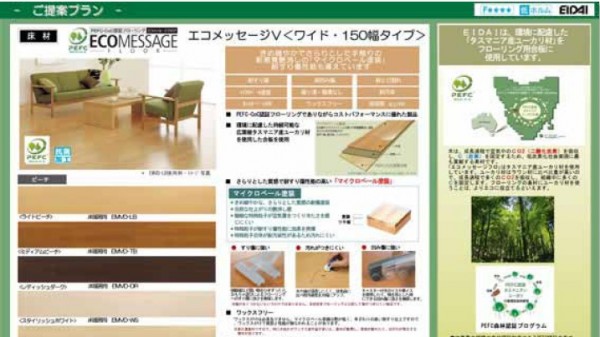 EIDAI Ad – this key Japanese retailer is one of 5 companies selling Ta Ann Tasmania’s wood under the banner of eco-wood. How did they arrive at such a conclusion?
EIDAI Ad – this key Japanese retailer is one of 5 companies selling Ta Ann Tasmania’s wood under the banner of eco-wood. How did they arrive at such a conclusion?
As we now know, these claims are simply untrue. It is not ‘eco-friendly’ to tear down old growth, ancient eucalypt forests, while at the same time giving the impression that you are only using plantation wood.
Driving the destruction of the forests Australia is TRYING to preserve
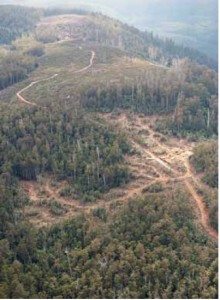 All to benefit Ta Ann – so far there has been no profit for Tasmania from the felling of their wild forests by Ta Ann, because the wood has been sold below market value and without profit!
All to benefit Ta Ann – so far there has been no profit for Tasmania from the felling of their wild forests by Ta Ann, because the wood has been sold below market value and without profit!
The most pernicious part of this whole story has to be its latest chapter. The Federal Australian Government has been doing its best to buy out the fag end of the Tasmanian logging industry from its business, before one of the world’s last great wildernesses is lost.
An agreement between the Federal and State Governments has therefore just been concluded whereby Tasmania’s remaining logging firms will receive major compensation, in return for putting aside another 430,000 hectares of forest for conservation.
The inter-governmental deal includes an agreement that until the final settlement is in place there will be NO logging in the identified areas. However, Tasmania’s State Forestry Department has been ignoring this inter-governmental agreement, in favour of contracts agreed with Ta Ann!
It turns out that Ta Ann has secured guaranteed wood supplies from the State owned logger, Forestry Tasmania until 2027 and is lobbying to extend it further till 2047 (why stop until the cheap trees are gone?). So, Forestry Tasmania has been continuing to log these areas, even though the public think they have been protected.
Indeed Tasmania’s forestry authorities have given notice they intend to log in no less than 87 coupes in wild forest areas supposedly protected under the recent law. Of these 59 are justified as part of the contracts agreed with Ta Ann.
“Logging for Ta Ann is also breeching the current Intergovernmental Agreement between the Australian and Tasmanian governments which has demanded logging be stopped in 430,000 hectares of high conservation value forests. Ta Ann’s operations here in Tasmania are far from eco-friendly and must rank amongst the worst logging practices globally,”[Jenny Webber HVEC]
Japanese companies who are marketing Ta Ann products from Tasmania should now take notice. Because if this is ‘eco-wood’, then consumers should be made aware. In fact it would be hard to find a situation that is less sustainable and less environmentally friendly than the clear fell destruction being waged by Ta Ann in Tasmania.
